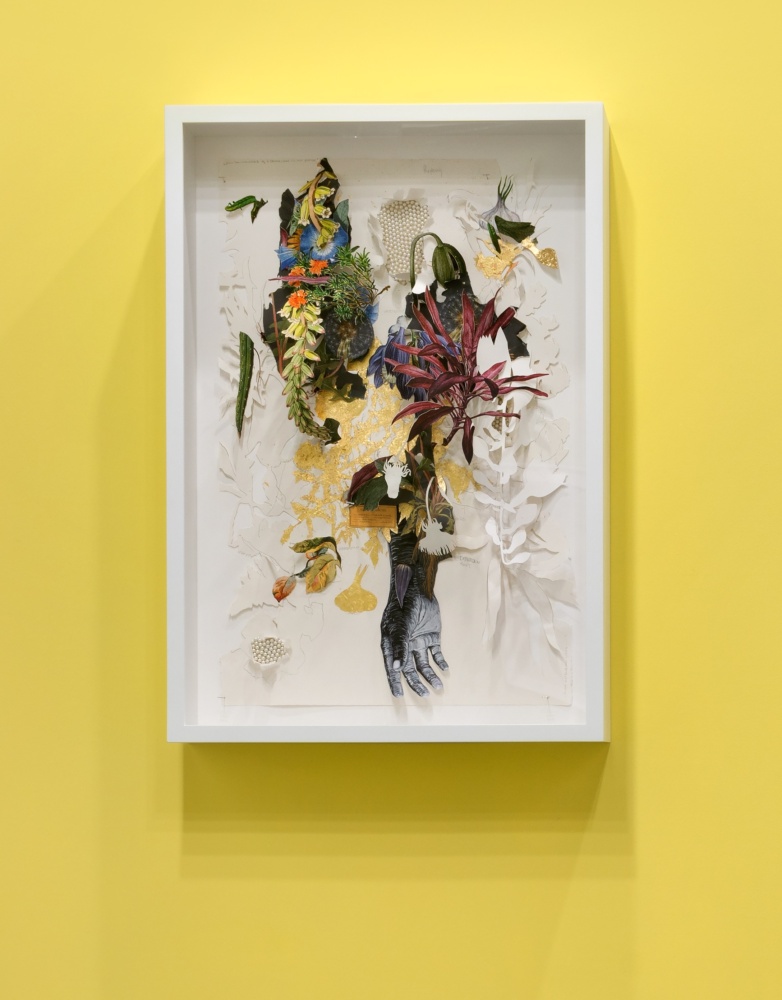
A Landscaped Longed for: The Garden as Disturbance is currently on view at the Crisp-Ellert Art Museum in St. Augustine, Florida. This marks the second iteration of the exhibition, which now features an expanded collection of artists who address identity, belonging, and historical reverence through the intricate visual metaphors associated with the garden.
Two rooms house the exhibition and visitors are welcomed by pollen-hued windows. The first space holds fourteen works that span traditional media of painting, drawing, printmaking, photography, and sculpture. The variety of visuals, textures, forms, and colors is in itself stimulating. The work of Cathy Lu, a newly included Chinese American artist, presents her ceramic sculpture Fruit Strand 15 (2002). Like A vine of plenty dropping down from an invisible canopy, the sculpture slowly and freely rotates, imbued it with life. Adorned with ginger root, papaya, lettuce, gourds, and other edible flora, the glazed surface boasts an earthy variety of blues, greens, browns, purples, and golds that hum with the reverence of tradition. By eating the same fruits and vegetables in China and America, this work synthesizes food and identity, creating a symbolic link between the artist’s cultural past, and present.

Another new inclusion in the exhibition is Kandice Williams’ work Genes, not Genius: The overlying purpose is to address how the social production of biologically determinist racial scripts—which extend from a biocentric conception of the human—can be dislodged by bringing studies of blackness in/and science into conversation with autopoiesis, black Atlantic livingness, weights and measures, and poetry. A biocentric conception of the human, it should be noted up front, refers to the law-like order of knowledge that posits a Darwinian narrative of the human—that we are purely biological and bioevolutionary beings—as universal; elegance is elimination (2021). We are confronted with a massive “potted plant”, standing at seven and a half feet, whose stems are wrapped in vines and end in a crown of leaves at the top. At a distance, the sculpture’s texture is obviously plastic, however, moving closer to the work reveals a surprising collage. Quietly adhered to the leaves, images of a body grow as one with the plant. The sculpture’s use of synthetic material, fashioned to look organic, speaks metaphorically to the manufactured nature of racism that persists in society. Here, despite the odds, the body flourishes, standing tall, and taking its place among the other plants in the garden.
The second room houses eight works, two sculptures, and six wall pieces. One of the original artists from the first iteration of A Landscape Longed For, David Hartt, presents Fragment (2014). True-to-life in scale, this bronze sculpture of an acanthus plant emerges from between terra cotta tiles. From a distance, the organic topography of the bronze seems to glow in the light like a smoldering verdure. This plant was removed from the host, taken out of context, and placed somewhere unexpected. The scale and material of the work are enchanting. Bronze is a living metal, changed through touch and patinaed with age. At this size, the sculpturetakes on a sacred quality, heightening the already impressive list of associations with the acanthus— immortality, victory, and beauty. This is the plant depicted in the relief at the top of Corinthian capitals, so there is a historical reverence at play. Fragment asks the viewer to observe closely, and quietly, to take in the warmly hued light resonating from the leaves and reflect upon symbolic associations with nature.
A Landscape Longed For: The Garden as Disturbance expressly reminds one that shared human histories of time and place are imbedded in the dirt. The timeless adage “When in doubt, turn to nature”, serves as a poignant reminder of the deep-rooted connections between the garden and the human experience. Plants, like people, hold histories often obscured by time or memory, yet their significance is felt empathetically. The exhibition offers an enriching garden that nourishes both the physical and spiritual needs of those who take the time to walk, look, and contemplate, among the plants.





